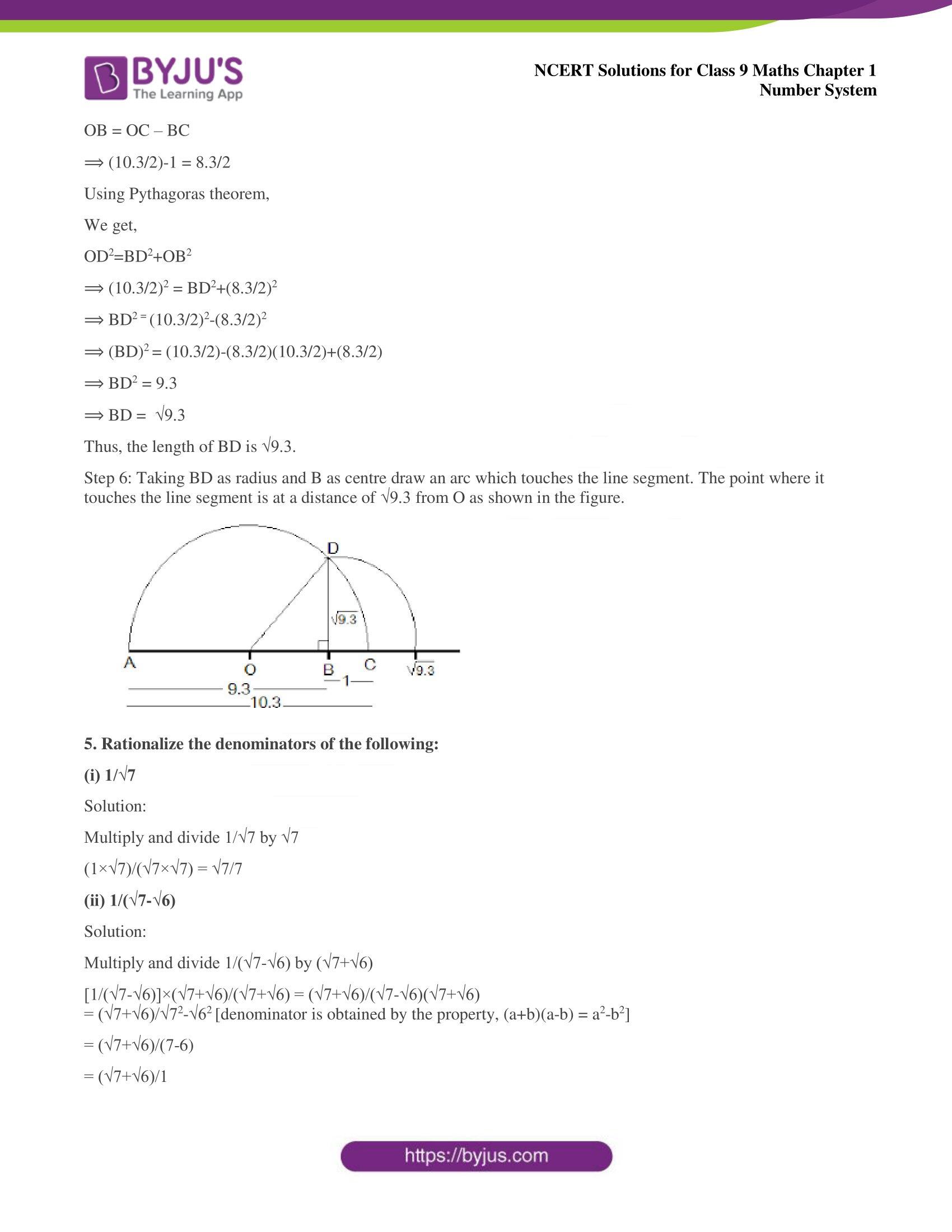NCERT Solutions Class 9 Maths Chapter 1 Number Systems Exercise 1.5 are given here for reference while solving the exercise problems. The fifth exercise in Number Systems – Exercise 1.5 discusses Operations on Real Numbers. For accurate and precise answers to the textbook questions, students can download the PDF for reference. The Class 9 Maths NCERT Solutions are designed by subject experts with the aim of helping students with their exam preparation.
The solutions provide a detailed and stepwise explanation of each answer to the questions given in the exercises in the NCERT Textbook for Class 9. The NCERT solutions are always prepared by following NCERT guidelines so that they should cover the whole syllabus. These are very helpful in scoring well in board examinations.

NCERT Solutions for Class 9 Maths Chapter 1 – Number Systems Exercise 1.5
Access Other Exercise Solutions of Class 9 Maths Chapter 1 – Number Systems
Exercise 1.1 Solutions 4 Questions ( 2 long, 2 short)
Exercise 1.2 Solutions 4 Questions ( 3 long, 1 short)
Exercise 1.3 Solutions 9 Questions ( 9 long)
Exercise 1.4 Solutions 2 Questions ( 2 long)
Exercise 1.6 Solutions 3 Questions ( 3 long)
Access Answers of Maths NCERT Class 9 Chapter 1 – Number Systems Exercise 1.5
1. Classify the following numbers as rational or irrational:
(i) 2 –√5
Solution:
We know that √5 = 2.2360679…
Here, 2.2360679…is non-terminating and non-recurring.
Now, substituting the value of √5 in 2 –√5, we get,
2-√5 = 2-2.2360679… = -0.2360679
Since the number – 0.2360679… is non-terminating non-recurring, 2 –√5 is an irrational number.
(ii) (3 +√23)- √23
Solution:
(3 +√23) –√23 = 3+√23–√23
= 3
= 3/1
Since the number 3/1 is in p/q form, (3 +√23)- √23 is rational.
(iii) 2√7/7√7
Solution:
2√7/7√7 = ( 2/7)× (√7/√7)
We know that (√7/√7) = 1
Hence, ( 2/7)× (√7/√7) = (2/7)×1 = 2/7
Since the number 2/7 is in p/q form, 2√7/7√7 is rational.
(iv) 1/√2
Solution:
Multiplying and dividing the numerator and denominator by √2, we get,
(1/√2) ×(√2/√2)= √2/2 ( since √2×√2 = 2)
We know that √2 = 1.4142…
Then, √2/2 = 1.4142/2 = 0.7071..
Since the number 0.7071… is non-terminating non-recurring, 1/√2 is an irrational number.
(v) 2
Solution:
We know that the value of = 3.1415
Hence, 2 = 2×3.1415.. = 6.2830…
Since the number 6.2830… is non-terminating non-recurring, 2 is an irrational number.
2. Simplify each of the following expressions:
(i) (3+√3)(2+√2)
Solution:
(3+√3)(2+√2 )
Opening the brackets, we get, (3×2)+(3×√2)+(√3×2)+(√3×√2)
= 6+3√2+2√3+√6
(ii) (3+√3)(3-√3 )
Solution:
(3+√3)(3-√3 ) = 32-(√3)2 = 9-3
= 6
(iii) (√5+√2)2
Solution:
(√5+√2)2 = √52+(2×√5×√2)+ √22
= 5+2×√10+2 = 7+2√10
(iv) (√5-√2)(√5+√2)
Solution:
(√5-√2)(√5+√2) = (√52-√22) = 5-2 = 3
3. Recall, π is defined as the ratio of the circumference (say c) of a circle to its diameter, (say d). That is, π =c/d. This seems to contradict the fact that π is irrational. How will you resolve this contradiction?
Solution:
There is no contradiction. When we measure a value with a scale, we only obtain an approximate value. We never obtain an exact value. Therefore, we may not realize whether c or d is irrational. The value of π is almost equal to 22/7 or 3.142857…
4. Represent (√9.3) on the number line.
Solution:
Step 1: Draw a 9.3 units long line segment, AB. Extend AB to C such that BC=1 unit.
Step 2: Now, AC = 10.3 units. Let the centre of AC be O.
Step 3: Draw a semi-circle of radius OC with centre O.
Step 4: Draw a BD perpendicular to AC at point B intersecting the semicircle at D. Join OD.
Step 5: OBD, obtained, is a right-angled triangle.
Here, OD 10.3/2 (radius of semi-circle), OC = 10.3/2 , BC = 1
OB = OC – BC
⟹ (10.3/2)-1 = 8.3/2
Using Pythagoras’ theorem,
We get,
OD2=BD2+OB2
⟹ (10.3/2)2 = BD2+(8.3/2)2
⟹ BD2 = (10.3/2)2-(8.3/2)2
⟹ (BD)2 = (10.3/2)-(8.3/2)(10.3/2)+(8.3/2)
⟹ BD2 = 9.3
⟹ BD = √9.3
Thus, the length of BD is √9.3.
Step 6: Taking BD as the radius and B as the centre, draw an arc which touches the line segment. The point where it touches the line segment is at a distance of √9.3 from O, as shown in the figure.


5. Rationalize the denominators of the following:
(i) 1/√7
Solution:
Multiply and divide 1/√7 by √7
(1×√7)/(√7×√7) = √7/7
(ii) 1/(√7-√6)
Solution:
Multiply and divide 1/(√7-√6) by (√7+√6)
[1/(√7-√6)]×(√7+√6)/(√7+√6) = (√7+√6)/(√7-√6)(√7+√6)= (√7+√6)/√72-√62 [denominator is obtained by the property, (a+b)(a-b) = a2-b2]
= (√7+√6)/(7-6)
= (√7+√6)/1
= √7+√6
(iii) 1/(√5+√2)
Solution:
Multiply and divide 1/(√5+√2) by (√5-√2)
[1/(√5+√2)]×(√5-√2)/(√5-√2) = (√5-√2)/(√5+√2)(√5-√2)= (√5-√2)/(√52-√22) [denominator is obtained by the property, (a+b)(a-b) = a2-b2]
= (√5-√2)/(5-2)
= (√5-√2)/3
(iv) 1/(√7-2)
Solution:
Multiply and divide 1/(√7-2) by (√7+2)
1/(√7-2)×(√7+2)/(√7+2) = (√7+2)/(√7-2)(√7+2)
= (√7+2)/(√72-22) [denominator is obtained by the property, (a+b)(a-b) = a2-b2]
= (√7+2)/(7-4)
= (√7+2)/3
Visit BYJU’S to access the NCERT Solutions of Class 9 Maths Chapter 1 in PDF format and speed up your exam preparation.





Thank you so much
I was searching for than answers and luckily I saw your answers which are easily understood.
thank you
This is a great learning app
Nice solution
Easy to understand ✌️
Easy to understand solution.
Nice
Nice